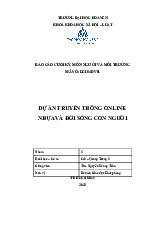



Preview text:
The 5 Best Ways to Store CO2 Pulled From the Air
Removing CO2 from the atmosphere is key to keeping temperatures from rising to disastrous levels.
Carbon dioxide (CO2) levels in the atmosphere are higher than they
have been inmore than 800,000 yearsand they’re projected to keep
increasing for decades to come.
And yet, the only way global temperatures can be kept from rising
above 2 degrees Celsius —the primary goal of the Paris climate
agreement— is to dramatically reduce greenhouse gas emissions like CO2 and methane.
This mismatch between aspirations and reality has forced
policymakers to turn their attention to a growing field known as
carbon capture, use, and storage (CCUS) — which essentially covers
all efforts to extract CO2 from the atmosphere and then store it in
some way to eliminate its environmental impact. The International
Panel on Climate Change (IPCC), the leading authority on the
subject,says that there’s almost no wayto achieve global climate
goals without pulling huge amounts of CO2 from the air. Tweet Now:
Global South Activists Are Demanding the US to Deliver Climate Justice: Share Their Voices 4,657 / 5,000 actions taken TAKE ACTION More Info
A new reportby the United Nations Economic Commission for Europe
(UNECE) describes how the full potential of CCUS technology can be fully unlocked.
While existing CCUS technology is unable to neatly cancel out current
rates of emissions,it can play a significant rolein mitigating the
climate crisis alongside concerted efforts to phase out fossil fuels.
In fact, the report notes that 10-30 gigatons of CO2 can be removed
per year by 2050 thanks to CCUS technologies and efforts. Countries
currently emit around40 gigatons of CO2 per year, and emissions
could rise to 50 gigatons by 2030. If countries invest in renewable
energy and reduce their overall energy consumption, then net-zero
CO2 emissions could be achieved within the UN’s desired timeframe.
But CCUS faces significant challenges that can only be overcome if
countries work together. Most immediately, financing must be
mobilized. The processes by which CO2 is removed from the
atmosphere, transported, and stored can be very expensive and, to
further complicate things, there’s really no way to turn a profit with
this technology. As a result, it’s up to governments to take the lead and invest. Related Stories
How Are We Going to Kickstart Global Climate Action?
The report calls on policymakers to build economies of scale to both
accelerate the adoption of these technologies and drive down costs.
For instance, if countries share the costs of building international
pipelines to transport extracted CO2 for storage, then it will be a lot
easier for countries with little storage capacity to invest in extraction
methods with the understanding that they’ll be able to transport the
CO2 somewhere else. In the process, the amount of CO2 that exists
in the borderless atmosphere will be gradually reduced.
Because climate change is a global problem, it requires a collective approach.
Since leadingclimate scientists expectCCUS technology to play an
increasingly vital role in the years to come, it’s important for
policymakers to begin developing frameworks and standardized
procedures today to ensure the field grows in the right direction.
Here are five of the best ways to store CO2 that’s been removed from the atmosphere. 1. Underground Storage
Essentially, after CO2 isremoved from the exhaust of a factory, it’s
heated and compressed, and then injected deep into porous rock
formations in the Earth. If the area is left undisturbed, the CO2 will
eventually turn into rock. If the area is disturbed, however, it can leak
CO2 and undermine the whole initiative.
This system hasn’t been rolled out on a large scale, the UNECE notes,
because of how expensive it is, how much energy it paradoxically
consumes, a general lack of lack of transportation infrastructure, and
a lack of storage capacity. Only some countries, for instance, have
adequate subterranean rock formations for CO2 storage.
The amount of infrastructure and underground storage needed for
this technique is staggering. If countries managed to remove 10% of
annual CO2 emissions in this way, the amount of liquid that would
need to be pumped underground would beequivalent to all of the oil used each year. 2. Nature-Based Solutions*
Forests, swamps, algae, and other natural areas offer a nature-based
solution to CO2 storage that'scheapandincredibly beneficial for the planet.
By restoring and conserving land and marine habitats, countries can
createcarbon sinksthat remove a significant amount of CO2 from
the atmosphere. In fact,the Nature Conservancyestimates that
nature-based solutions can provide 37% of the emissions reductions
needed to keep temperatures under the 2 degrees Celsius threshold. Related Stories
Why Are the Next 10 Years So Key for Climate Action? 3. Concrete*
CO2 that has been recovered from the atmosphere is increasingly
being usedto manufacture concrete. During the industrial
manufacturing process, CO2 can be substituted in for some
components and become a part of the final product. While concrete
can’t hold the CO2 indefinitely — it eventually breaks down — it’s one
of the longest lasting ways to store the substance. 4. Plastics*
While many types of plastics are anenvironmental hazardand need
to be phased out, the group of chemical substances known as plastic
have become acore part of the global economy. The UNECE report
describes how some companies are incorporating CO2 that has been
extracted from the atmosphere into the manufacturing process of
plastics that can potentially hold onto it for centuries. 5. Synthetic Fuels*
The fossil fuel industry uses a lot of energy on its own to extract coal,
oil, and natural gas from the Earth, process it, and then ship it around the world.
The environmental footprint of this system can be dramatically
reduced bymaking synthetic fuel with CO2pulled from the air and
other elements. This shift could both satisfy some of the demand for
fossil fuel products, while also minimizing the harm of burning them.
Synthetic fuels are ultimately a stop-gap measure as societies
transition away from fossil fuels, but, when they become
economically viable, they could help to reduce overall emissions.




